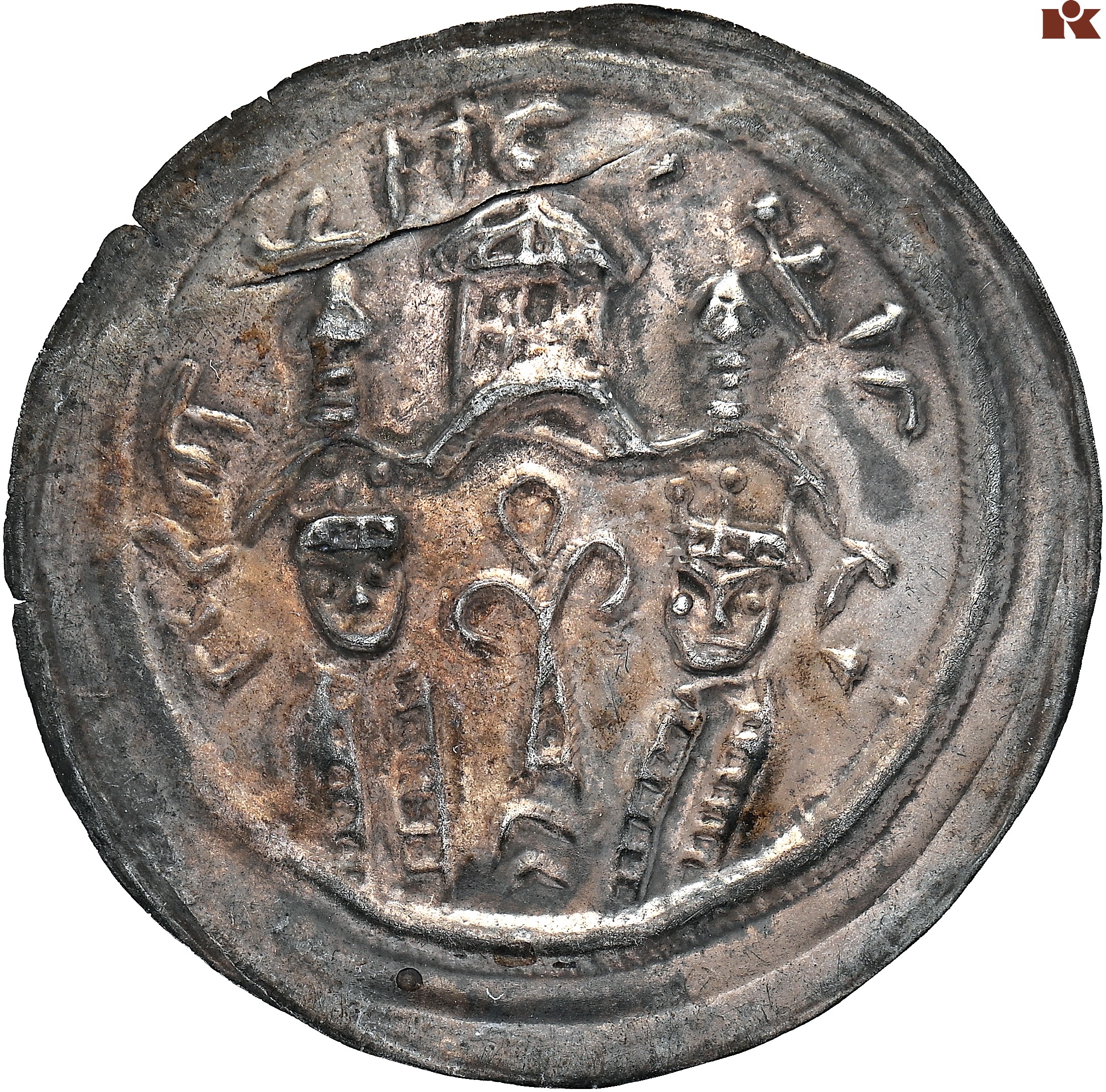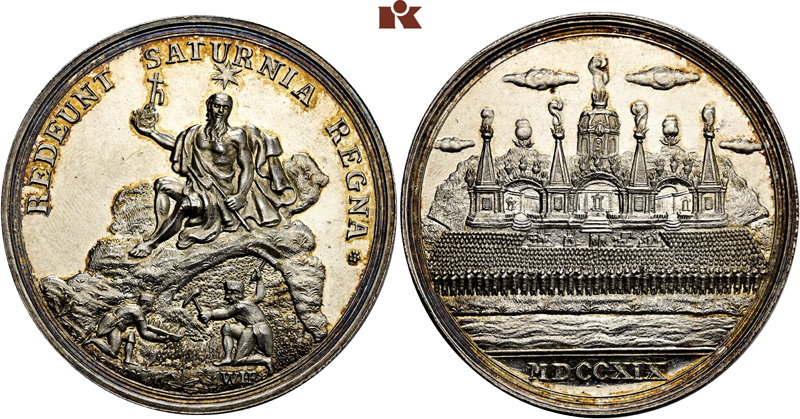Review of our eLive Premium Auctions 389-390: Saxon Coins in high demand
11. July 2023 13:01
Auction 389 contained, among other things, an extensive series with coins from Bremen-Verden as well as the last part of the Dr. Walter Kemmlein Collection with Saxon issues. Auction 390 presented the last part of the Salton Collection with a clear focus on Roman antiquity, Italy and the German states. While the total estimate of both auctions had been 630,000 euros, the hammer price was twice as much and amounted to 1.5m euros. In this review, we present some exciting results.
No. 2162: Bremen-Verden. Charles XI, 1660-1697. 1674 reichstaler, Stade. Rare. Very fine +. Estimate: 1,000 euros. Hammer price: 3,400 euros.
Bremen-Verden
There is a good reason why a Swedish king is depicted on the reverse of a coin from the formerly Catholic dioceses of Bremen and Verden. After the Reformation, the dioceses were turned into Protestant territories. The Peace of Westphalia of 1648 then stipulated that the territories were to be given as a single duchy to Sweden, the big winner of the Thirty Years’ War. Künker had the privilege of offering a large series with coins from this duchy. One of them will be presented here, a 1674 reichstaler that was minted in the Swedish city of Stade. Stade was another territory that had only become part of the Swedish Empire since the Peace of Westphalia. Prior to the Thirty Years’ War, it had been a free imperial city and member of the Hanseatic League. The attractive and rare taler was estimated at 1,000 euros. A collector was willing to pay more than three times that, 3,400 euros to be precise. This was just one of many impressive results; the total hammer price for the entire ensemble amounted to more than twice its estimate.
No. 2301: Saxony. Vladislaus II of Bohemia, 1158-1173. Bracteate, Bautzen or Görlitz. From the Kemmlein Collection. Extremely rare. Extremely fine. Estimate: 3,000 euros. Hammer price: 3,900 euros.
Saxony – the Dr. Walter Kemmlein Collection
The same auction sale offered the last part of the Dr. Walter Kemmlein Collection, an impressive special collection of Saxon coins and medals, including many rarities. Let us take, for example, this extremely rare and historically interesting bracteate with Hebrew inscription. It is not the only bracteate with a legend in Hebrew. Regarding bracteates from Meissen and Poland, we know that Jewish bankers were the reason for such a legend. As the major trade hub in Upper Lusatia, Görlitz also had a Jewish community in the early 13th century. The Hebrew inscription could be related to this circumstance. The future owner of the coin might solve the riddle. Given how exciting this will be, the hammer price of 3,900 euros (against an estimate of 3,000 euros) was certainly worth it.
No. 2338: Saxony. John George I, 1615-1656. Silver medal commemorating the conquest of the city of Bautzen in 1620. From the Kemmlein Collection. Very rare. Very fine. Estimate: 200 euros. Hammer price: 2,300 euros.
Overall, Saxon history seems to be a hot topic for collectors right now. This is clearly reflected by the fact that medals from the Kemmlein Collection experienced significant increases in price. In this way, bidders acknowledge that medals are usually rarer and almost always of higher artistic value than coins. As an example for this trend, we present a very fine silver medal commemorating the conquest of Bautzen, which is slightly worked at the edge. A collector considered the piece worthy of a 2,300-euro bid, i.e. 11.5 times its estimate.
No. 2424: Saxony. Frederick Augustus I, 1694-1733. Silver medal commemorating his son’s wedding to Archduchess Maria Josepha of Austria in 1719. From the Kemmlein Collection. Very rare. Extremely fine to FDC. Estimate: 1,000 euros. Hammer price: 17,000 euros.
Even more extreme was the result achieved by an exceptionally well preserved medal, of which a few pieces were produced for the wedding of the son of Augustus the Strong and the Emperor’s daughter Maria Josepha. Its outstanding quality was not the only reason for the high price. Archival sources and contemporary depictions tell a lot about the event that is depicted on the medal’s reverse. You can find out more about it in our article “The Wedding of a Century in Saxony”. However, this medal is not only of interest to collectors of Saxon issues. Due to the depiction, it is also attractive for collectors of mining issues. And since there are a lot of them across the globe, there was a lot of competition. The result: the hammer for this piece estimated at 1,000 euros only fell at 17,000 euros!
Article: The Wedding of a Century in Saxony
No. 3077: Roman Republic. Denarius, 34 BC, Alexandria. Marcus Antonius / Cleopatra. From the Salton Collection. Very rare. Very fine. Estimate: 1,000 euros. Hammer price: 3,000 euros.
The Salton Collection
On 24 June 2023, the last part of the spectacular Salton Collection was auctioned off – as always, quite successfully so. The total hammer price was almost 2.8 times its estimate, and this increase did not only affect top-quality coins.
As it is the case for every old collection, the Saltons attached greater importance to historical significance than to an object’s quality. Many collectors still appreciate this, which is why the denarius with the portrait of Marcus Antonius and Cleopatra – which was “only” of very fine quality – tripled its estimate of 1,000 euros and realized 3,000 euros.
No. 3222: Marcus Aurelius, 161-180. Aureus, 177/8. Very rare. Extremely fine. Estimate: 10,000 euros. Hammer price: 20,000 euros.
When historical importance and above-average quality come together, prices obviously go up even more. This is also true for an aureus by Marcus Aurelius, whose estimate of 10,000 euros was doubled when the hammer fell at 20,000 euros.
No. 3836: Bavaria. Ludwig I, 1825-1848. Double vereinstaler, 1844. “Feldherrnhalle”. About FDC. Estimate: 300 euros. Hammer price: 3,600 euros.
The huge importance of a coin’s quality can also be illustrated by an example from the 19th century: one of the readily collected Bavarian history talers (“geschichtstaler”), to be precise the “Feldherrnhalle” specimen of 1844. This coin type is far from rare. However, it is rare to find a specimen that clearly shows all the details of the portrait and the reverse depiction. Zoom in as much as possible and take a look at the coin: you will recognize all the details. Those who collect these issues know how rare such high-quality pieces are. That is the reason why the coin achieved twelve times its estimate and was sold for 3,600 euros.
No. 3793: Olomouc / Diocese. Ferdinand of Troyer, 1745-1758. Reichstaler 1752. Very rare. Obv. very fine to extremely fine. Rev. extremely fine. Estimate: 750 euros. Hammer price: 23,000 euros.
Let us round off this little review with the most expensive coin of the two eLive Premium Auctions, a 1752 reichstaler from the Diocese of Olmütz (Olomouc) of exceptional quality. Admittedly, the estimate was quite low, but nobody expected a hammer price of 23,000 euros.
Take a look at the complete list of results of Künker’s eLive Premium Auctions. You will notice two things: For one, many highly interesting coins were sold for comparatively low sums. And secondly, consignors who offer their collection in an online-only sale are no longer at a disadvantage in this day and age.
If you have any questions, please do not hesitate to contact us at Künker, Nobbenburger Str. 4a, 49076 Osnabrück; phone: +49 541 / 962020; fax: +49 541 / 9620222; or via e-mail: service@kuenker.de. You can find the auction results online at www.kuenker.de.









